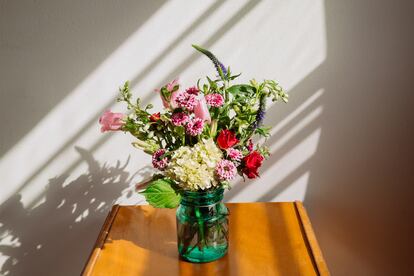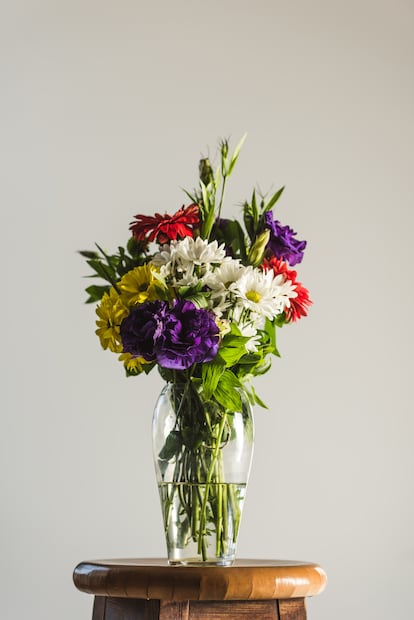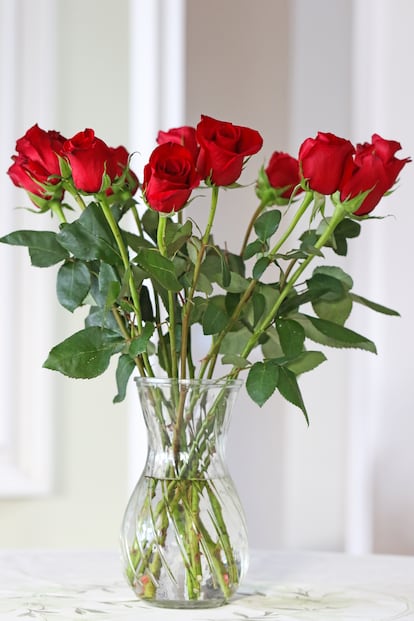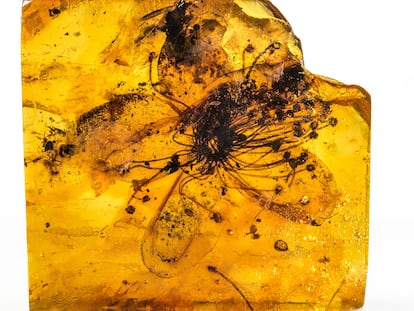Why do we like to give and receive flowers on Valentine’s Day?
Without saying a word, flowers proclaim affection, seduction, commitment, desire, tenderness, and fidelity. They represent infinite ways to say ‘I love you’

The language of flowers is loaded with symbolism and beauty. It is universal and profound. It is also the most eloquent in its simplicity. In these times of artificial intelligence, augmented realities, threads, reels, microblogging, and ChatGPT, we are still able to express our most heartfelt emotions with flowers.
“In prehistoric societies flowers constituted food for man, but they began to be used as symbols and amulets in offerings and rituals around 9,000 years ago. That was the beginning of floral culture,” explains architect and landscape designer Marta Gallego, who is also a professor of Garden History at the Castillo de Batres School of Landscaping. Ancient Egypt is the first time in history that the use of floral arrangements among the elites and in the environment of the pharaohs was documented. With the blue lotus (Nymphaea caerulea) as the star, bouquets were made for funeral cults, there were garlands for parties, and crowns for celebrations.
In ancient Greece, flowers and vegetables became popular among all social classes as offerings to the gods and to celebrate victories in battles. Cornucopias emerged that combined flowers and fruits as a symbol of abundance and wealth, and heroes were adorned with laurel wreaths. Species with symmetrical shapes, such as lilies, orchids, and daffodils were the most appreciated due to their geometric perfection.
Mythology also gave symbolic value to flowers by relating each species to a god or goddess. Roses were Aphrodite’s flower. This is the first historical link that connects the “Queen of all flowers” with love, and it is the first outline of a language of flowers, which at the time was still very primitive. “There are also references in Eros and Psyche, a myth from Antiquity loaded with plots of love, heartbreak, crushes, and jealousy that culminates with a marriage for eternity in which red roses sprouted on Olympus,” Marta Gallego adds.
Roses for Aphrodite and for all lovers
Today, seven out of every 10 flowers sold in Spanish florists on Valentine’s Day are roses, according to the Spanish Association of Florists (AEFI). “For Valentine’s Day alone, each florist sells an average of 800 rose stems. Not to mention wild bouquets, carnations, arrangements of preserved flowers, compositions of cut flowers in baskets, or candy boxes for those looking for something different. There are ornamental potted plants, such as the orchid, loaded with erotic connotations thanks to mythological stories, for those who prefer living flowers,” says AEFI.
Marta Gallego explains a curious fact: “The Anglo-Saxon tradition of Valentine’s Day did not reach Spain until the middle of the 20th century. It was introduced by the founder of Galerías Preciados, who saw that there was money to be made from the custom of giving flowers and generating consumption using a day dedicated to love as an excuse.” Thus, from their department stores on Madrid’s Gran Vía, the gesture of giving flowers and chocolates on February 14 immediately spread to the rest of the country.

Dahlias, lilies, orchids, and daisies for all types of love
“It is believed that the custom of giving flowers as a demonstration of love dates back to weddings in the Middle Ages, when it became fashionable to decorate wedding celebrations with bouquets to perfume the atmosphere and mask unpleasant odors,” says landscaper Fernando Pozuelo.
Beyond this unusual cosmetic function, the true turning point in the use of the flower as a signifier of love in Western cultures took place in the 19th century, when floral art became a symbol of status and good taste in Victorian society. “Wealthy ladies attended classes to master the design of bouquets and arrangements, and strict rules were established regarding the use of the various species and the combination of shapes and colors,” explains Marta Gallego.
Thus, floriography or the language of flowers was born, a shibboleth that only members of the plant art cognoscenti are able to interpret. Bouquets and floral displays promote a silent form of social expression that is equivalent to the language of the fan. Depending on the flower that is chosen, the color, the position of the stem when delivering it, the hand (right or left) with which the recipient takes it, or the context surrounding the moment of delivery, the eloquence of what was expressed without saying a word was almost infinite. “The rose, with all its varieties and cultivars, was the star of the show,” says Gallego.

Due to its centuries-long historical and artistic connection with the beautiful and carnal Aphrodite, the red rose embodies desire and passion in floriography. The dahlia expresses eternal fidelity and commitment. The Peruvian lily or alstroemeria signifies devotion and unconditional friendship. “The orchid, as a symbol of lust and sensuality, and the daisy, as a symbol of purity and tenderness, are other species that refer to various ways of professing love,” adds Fernando Pozuelo.
Likewise, the almond flower connects floriography with the story of Saint Valentine himself. In defiance of the laws of the Empire, the Roman monk secretly married soldiers, who were prohibited from marriage so as not to be distracted from their obligations in battle. He was discovered and tortured, and died on February 14. An almond tree was planted next to his grave. The pink almond blossom, which blooms at this time of the year, symbolizes the eternal strength of love.
The eloquence of flowers
Curiously, in an increasingly technical and virtual environment, the language of flowers has continued to enrich and inspire our ability to express our feelings. Although the exact codes of floriography are barely used anymore, everyone interprets the gesture of giving a bouquet or corsage as an unequivocal sign of love — albeit in varying degrees from lustful to romantic to platonic.
The democratization of flowers as an ornament and as a gift has allowed us to dispense with the exclusive and elitist language used by 19th-century gentleladies, and today there are many people of all socioeconomic statuses who give and receive flowers as a token of love. Flowers embody many of the attributes and qualities associated with desire and affection including pleasure, seduction, trust, attraction, fidelity, lust, and commitment.
“In addition, it is scientifically proven that surrounding yourself with plants provokes a positive emotional response in humans that connects us with feelings of joy, fulfillment, happiness, and well-being that are triggered by being in love,” Fernando Pozuelo says. This innate sense of connection with nature improves mood, reduces stress, connects both the giver and the recipient with the present and the idea of carpe diem, and allows us “to express positive feelings without the need for words,” the landscaper adds.
“Analog is sexy”

More than a thousand years after the decoration of wedding ceremonies sparked the trend of surrounding oneself with flowers to celebrate love, we still like giving and receiving flowers “for the same reason that we like a hug from our mother or a scent that takes us back to childhood,” says Jesús Viñambres, from the Madrid florist Lufesa. “Flowers evoke feelings that transport us to moments of happiness. Being given the latest in technological doodad is great, but such objects will never be able to move your emotions. They do not allow us to forge ties with nature or with the people you love. Plants do,” he says.
The plant world nourishes the body, and also the spirit. That is why the aesthetic and stimulating language of flowers is and will always be perfect for communicating our deepest feelings. Analog is sexy. And flowers will always be the most eloquent way to say “I love you.”
Sign up for our weekly newsletter to get more English-language news coverage from EL PAÍS USA Edition
Tu suscripción se está usando en otro dispositivo
¿Quieres añadir otro usuario a tu suscripción?
Si continúas leyendo en este dispositivo, no se podrá leer en el otro.
FlechaTu suscripción se está usando en otro dispositivo y solo puedes acceder a EL PAÍS desde un dispositivo a la vez.
Si quieres compartir tu cuenta, cambia tu suscripción a la modalidad Premium, así podrás añadir otro usuario. Cada uno accederá con su propia cuenta de email, lo que os permitirá personalizar vuestra experiencia en EL PAÍS.
¿Tienes una suscripción de empresa? Accede aquí para contratar más cuentas.
En el caso de no saber quién está usando tu cuenta, te recomendamos cambiar tu contraseña aquí.
Si decides continuar compartiendo tu cuenta, este mensaje se mostrará en tu dispositivo y en el de la otra persona que está usando tu cuenta de forma indefinida, afectando a tu experiencia de lectura. Puedes consultar aquí los términos y condiciones de la suscripción digital.
More information
Últimas noticias
Most viewed
- Reinhard Genzel, Nobel laureate in physics: ‘One-minute videos will never give you the truth’
- Oona Chaplin: ‘I told James Cameron that I was living in a treehouse and starting a permaculture project with a friend’
- Pablo Escobar’s hippos: A serious environmental problem, 40 years on
- Why we lost the habit of sleeping in two segments and how that changed our sense of time
- Chevy Chase, the beloved comedian who was a monster off camera: ‘Not everyone hated him, just the people who’ve worked with him’










































